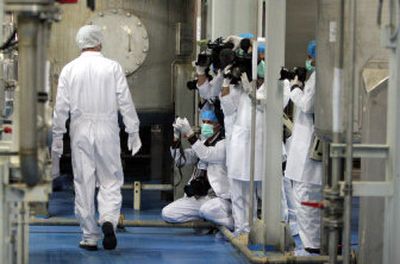Iran invites foreigners into nuclear fuel plant

ISFAHAN, Iran – The squat, tan buildings with barred windows can be reached only by driving well outside the city to a flat stretch of desert on the edge of the hills. The site is surrounded by an array of anti-aircraft artillery emplacements, each with one or two soldiers at the ready, and a large metal fence topped with barbed wire.
Once inside the reception hall, visitors are greeted by a huge poster that says: “Nuclear Energy Is Our Obvious Right.”
Here, in a city considered the heart of its nuclear development program, is where Iran has been taking the initial technological steps to turn ordinary uranium into the makings of nuclear fuel.
In a rare invitation to foreign visitors Saturday, Iranian officials opened the doors of the normally closed facility. The officials reported that the fledgling conversion program, which was in its infancy only three years ago, has manufactured 250 tons of uranium hexafluoride gas, the feedstock for Iran’s controversial uranium enrichment program.
The group included visitors from all over the world, said Ali Asghar Soltanieh, Iran’s ambassador to the International Atomic Energy Agency. “We have decided they would come here to have the opportunity to see themselves what is going on,” he said as they walked through the large rooms of tanks, feeder lines, pressure gauges and control panels.
The official delegation of seven included representatives of the Non-Aligned Movement, the G-77 group of developing nations and the Arab League, all accredited to the IAEA in Vienna, Austria. Iranian officials allowed a group of journalists to cover the visit.
“We want to remove these ambiguities and questions from our Arab brothers and sisters in the region. They have to know that everything is transparent and it is for peaceful purposes, and there is no concern as far as safety is concerned,” Soltanieh said.
The uranium conversion facility at Esfahan is only a piece of Iran’s nuclear program, which the Islamic republic says it is pursuing in order to develop new sources of electrical power and maintain the nation’s high level of oil exports.
The next and most controversial step is conducted at an even more secret plant at Natanz to the north, where the feedstock material produced at Esfahan is processed through a series of centrifuges to enrich the uranium for use as fuel for nuclear reactors. Enriching it far more than that, a level beyond Iran’s present capability, most experts believe, would be sufficient for use in a nuclear weapon.
The U.S. and some other countries believe that might be the ultimate target of Iran’s power program, but Iran insists it is opposed to nuclear weapons and simply would withdraw from the Nonproliferation Treaty if it wanted to build one.
The U.N. Security Council has adopted a first tier of sanctions against Iran, which freezes some assets and bars companies from selling materials and technology that could contribute to its nuclear program.
Saturday’s tour was mainly a publicity exercise; the delegates admitted they understood little of what they were seeing. But it was clearly part of a strong effort on Iran’s part to demonstrate its willingness to open up its nuclear program to inspection.